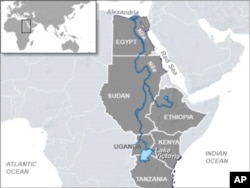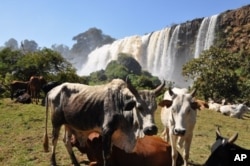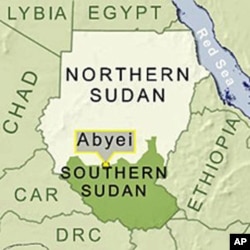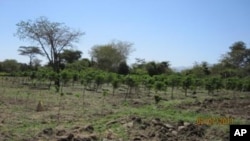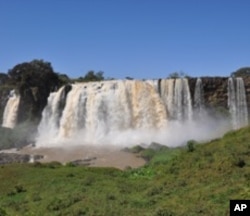This is Part 2 of a 5-part series: Sharing Nile Waters
Parts 1 / 2 / 3 / 4 / 5
The Nile is the world’s longest river, spanning a distance of almost 6,600 kilometers.
It is formed from the White Nile, which originates in the Great Lakes region of central Africa, and the Blue Nile, which begins at Lake Tana in Ethiopia. The two rivers meet in Sudan and travel northwards, flowing through Egypt and seven upstream countries before finally emptying into the Mediterranean Sea.
Water use issues have long been a source of contention among the Nile Basin countries, who disagree on what is an equitable distribution of the river’s waters.
For decades the answer to that question has been determined by an agreement that’s recently re-negotiated and that could alter the historic water-sharing arrangements for the Nile.
Entitled the Cooperative Framework Agreement, it was signed in late February by Burundi, which joins other countries -- Kenya, Uganda, Ethiopia, Tanzania and Rwanda – that are seeking what they consider a more equitable share of the river waters.
Egypt, Sudan and the Democratic Republic of Congo are still mulling over the framework’s provisions.
The accord was prepared during 11 years of negotiations among nine of the 10 countries in the basin. Eritrea did not participate directly in these negotiations but did serve as an observer. Last May, the document was put forward for signature by the participating governments.
Richard N. Tutwiler, a research professor and director of the Desert Development Center at the American University in Cairo, says with Burundi’s signing, the countries can move on to ratification.
Article 14b
After the sixth signature, says Tutwiler, the agreement stipulates the formation of a commission among the Nile Valley countries to review water control projects along the river basin.
“We can expect things might start happening in terms of this commission as early as May of this year,” says Tutwiler.
Egypt and Sudan have reservations about the cooperative framework agreement. “In particular,” says Professor Tutwiler, “article 14 of the agreement is very much in dispute,” especially between downstream countries, Egypt and Sudan, and the other countries.
The issue is water security.
Article 14b does not recognize the historic right of Egypt to 55.5 billion cubic meters of the Nile’s waters, as did the 1959 treaty.
“[Egypt does not] have the power to turn on or turn off the tap of the Nile,” says Tutwiler. “So it is important to point out that Egypt has been lobbying very hard at the negotiating table and with international bodies to define water security so as to maintain the same amount of water it is receiving now and looking to the future as it moves forward.”
Rules of ratification
Professor Tutwiler says ratification is a two stage process. Once governments sign the treaty, it must be ratified by the legislature. Out of the nine Nile basin countries, six have signed.
Egypt and Sudan have announced they don’t intend to sign the present document in its present form. The DRC is still undecided, but most people think it will sign by May, which, according to Tutwiler, “is the one-year period for signature from the time the document was introduced.”
In the second stage, national legislatures must ratify the agreement. For each country, the process is slightly different, says Tutwiler.
“The idea is if six countries ratify, at least [in those countries] the agreement becomes the legislative law in operation. In other words, among the ratifying countries, they have agreed that it will be a governing document for relations among themselves in terms of cooperation regarding water use,” explains Tutwiler.
“As far as Egypt is concerned,” Tutwiler says, “it does not agree, [even though] if six signed, by default it is bound by the agreement.”
But according to al-Ahram Weekly, Egypt’s assistant foreign minister for African Affairs, Mona Omar, said the new accord is non-binding because Egypt has not signed. An official spokesman for the Egyptian Ministry of Irrigation and Water Resources, Essam Khalifa, says the issue can be amicably resolved “with a little bit of understanding regarding the needs of the conflicting parties.”
Nile River Treaties
The treaty of 1929, between Egypt and then-colonial power Britain, was among the first to govern waters in international river basins. It gave Egypt permission to build whatever projects it liked along the Nile without the consent of other parties, while allowing Cairo to veto up-stream projects that could threaten its share of water.
But Tutwiler points out that post-colonial governments do not recognize it as binding. Tutwiler says the 1959 treaty is recognized as definitive. It guaranteed Egypt 55.5 billion cubic meters of water per year, and Sudan 18.5 billion. The treaty was used as the basis for the agreement between Khartoum and Cairo to build the Aswan dam, which flooded a large part of northern Sudan.
He says none of the upstream countries, such as Uganda, Tanzania, or Ethiopia, recognize the 1929 agreement as valid.
Water wars
President Anwar Sadat once famously threatened Ethiopia with war if it diverted water out of the Nile Basin into other areas of Ethiopia. Tutwiler says, “By and large Ethiopia has not done that, although they have talked about it and have various projects on the drawing board.”
But Tutwiler says Egypt has. “Egypt has taken water out of the Nile and put it across the Suez Canal and into the Sinai, which is not geographically speaking part of the Nile Basin,” he says.
“Ethiopia was very quick to point that out. This was almost 40 years ago, and not since Sadat has Egypt ever threatened Ethiopia in the same way with military action,” she says.
The difficulty of taking military action within the Nile Basin very much work against any real military action, says Tutweiler. Much of the terrain is harsh and Egypt is limited in the reach of its air power.
But he says there’s room for recourse to diplomatic and economic actions and solutions.
Focus on Sudan
Tutwiler says many observers are watching Sudan.
In January, southern Sudanese voted for independence. “The creation of a new southern Sudan state changes the whole equation,” Tutwiler says. So far, the government of southern Sudan has not actually articulated a Nile Basin policy.
Most observers assume that southern Sudan would not want to give up any water that passes through its territory.
According to Tutwiler, one of the major historical issues regarding Sudan has been a project first proposed by the British in 1904 to build a very long canal in southern Sudan. The world’s largest fresh water swamp is in southern Sudan and half of the Nile water flows from equatorial Africa into that swamp and, he says, “evaporates before it can move on northward to the White Nile.”
The idea of the project is to dig a canal called the Jongeli Canal around the swamp to divert the water flowing to the swamp into the canal. Tutwiler says the project could save up to eight million cubic meters of water from evaporation that could then be used in northern Sudan and on into Egypt.
“Egypt of course would like to have the canal built. They have already started discussion with north and south Sudan on the issue,” Tutwiler says.
So far, the southern Sudanese are not saying they are for it or against it. For now they say it is not a major priority for them because they have a nation to build.
“But one suspects that they would not like to divert that water from the swamp, because in fact southern Sudanese people who live there depend on the swamp for much of their livelihood,” says Tutwiler.
“These people are cattle herders and they need the water. The swamps provide grazing land. If the swamps were to be drained,” Tutwiler says, “those people would suffer economically.”
Southern Sudanese seem not to be interested in pursuing the project and, according to Tutwiler, it might cause problems between them and the northern Sudanese, allied with Egypt.
Future of the Nile
Tutwiler says Egyptians are always worried about the future of the Nile, the country’s main supply of fresh water.
“Egyptian concerns are real and well founded,” says Tutwiler. He adds that Cairo’s position for now will be to focus on the question of water security, which is the bone of contention in the current draft agreement.
As far as the states in the region are concerned they will try to persuade the Egyptians that they are also committed to the notion of equitable use of the Nile waters.
Egypt is focused on maintaining the current arrangement.
“Their position essentially is, ‘If you leave us to keep 55.5 billion cubic meters of water, we will live within that envelope.’” Tutwiler says, “That will not be easy for the Egyptians because every year the population grows. In fact, every three weeks there is another 100 thousand net gain in the population and the water stays the same,” asserts Tutwiler.
Water scarcity
The United Nations says water scarcity exists when a country goes below the national average of 1000 cubic meters per person per year. Egypt needs 80 billion cubic meters of water a year just to avoid water scarcity. Tutwiler says, “Egypt has long passed that threshold because it doesn’t have anywhere near that amount of water for 80 million people.”
Tutwiler says Egypt is making what he calls an admirable effort to develop a strategy to conserve and recycle water and live within its means.
“I think the other countries will probably try to persuade Egypt that whatever specific project that are being proposed will not substantially harm Egypt’s interests, and this I think will be what they will try to say to keep the Egyptians involved in the discussions as cooperators and partners in the basin,” says Tutwiler.
He adds that the Egyptians are willing to discuss those issues in good faith but still are going to think in terms of a kind of bottom line, which is their water security.
Ethiopia’s Blue Nile
Eighty percent of the Blue Nile flows from Ethiopia and reaches the Aswan Dam on the border of Egypt and Sudan. Ethiopia is the key as far as Egypt is concerned
Lately, Ethiopia has undertaken an ambitious program of dam construction in parts of the Nile basin located in its territory. The country has a deficit of power, and most of these dams produce electricity, although some have small irrigation components.
Some studies indicate that properly managed hydro-power dams in Ethiopia could benefit Egypt with more water. “You cannot generate electricity in a hydro-dam unless you let the water through the dam,” explains Tutwiler.
“Secondly,” Tutwiler says, “if you build up a head [of stored water behind the dam] to generate electricity, then in effect you are storing water in Ethiopia where you don’t have nearly as much evaporation as you would in Lake Nasser in the Sahara desert in Egypt and northern Sudan.”
The Blue Nile in Ethiopia is a seasonal river. Most of the water accumulates in the monsoon season between June and September. “By building hydro dams Tutwiler says, “You can actually reduce the effects of flooding and even out the water flow throughout the year.”
This in turn benefits Egypt in terms of the amount of water it can use. According to Tutwiler, it is a kind of ecological balance between, hot season, rainy season, cooler temperatures and hotter temperatures.
What to do
“There are many technical solutions as well as developmental projects that can be implemented to improve the ecological balance of the Nile basin,” says Tutwiler.
In the case of Egypt, there is much that can be done to save and reuse water. Tutwiler says Egyptians are actually very much in line with improving their water use efficiently.
Upstream, where the water is generated by rainfall, it’s a different story.
In Ethiopia Tutwiler says, “The watersheds over the last hundred years have suffered a great deal of degradation primarily to deforestation and bad agricultural practices that have created more erosion.”
Tutwiler says the Ethiopian National Water Resources Management Plan has adopted a strategy to try to revitalize a lot of the watershed eco-system so more water can be retained in the soil and in the geology of the Ethiopian highlands.
This would ultimately benefit the downstream countries, because more water would be saved in an ecological and environmentally friendly way with less water lost to run-off or evaporation.
The China connection
Tutwiler says politics are changing for the Nile countries.
He says as in other African countries, many Nile nations are becoming more stable, and gaining more control over their national territory.
“Ethiopia is a good case in point,” says Tutwiler. “Since the 1970s, after the fall of Emperor Haile Selassie, we had prolonged civil wars and instability, and now for almost 20 odd years Ethiopia has had relative stability.
The country is starting to develop. With all these projects in Ethiopia, such as hydro-power plants, the electricity grid extending outwards, water and sanitation improving, society seems to be progressing economically, though maybe not as fast as they should.”
Tutwiler says, “It is the same in Uganda. The country went through a long period of instability and is now starting to firm up and to make progress.”
He says there’s also a great deal of international interest in foreign investment in the Nile basin region today.
Tutwiler says one of the big players in the Nile basin is China, which is helping finance and build dams in Sudan and Ethiopia.
“Previously,” Tutwiler says, “these large dam projects could only be refinanced through institutions like the World Bank. The World Bank used to use its policy to mediate among competing interests in the basin. Now all that has been replaced by the Chinese.”




